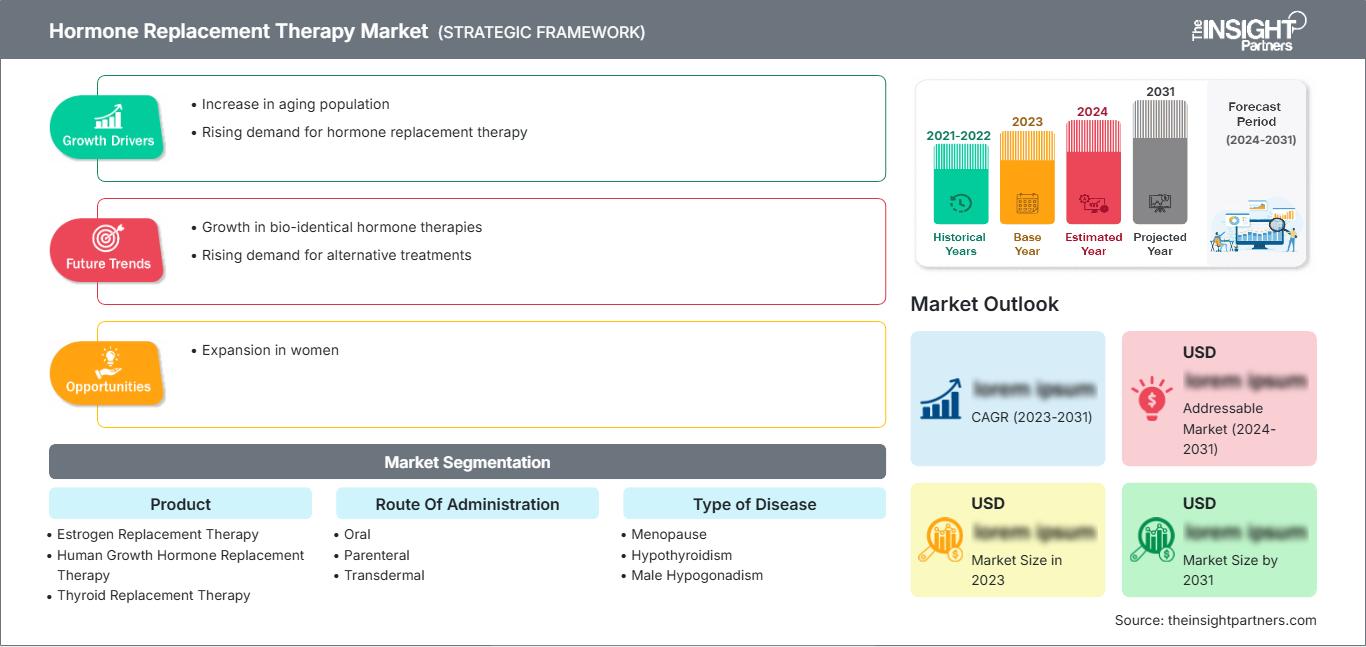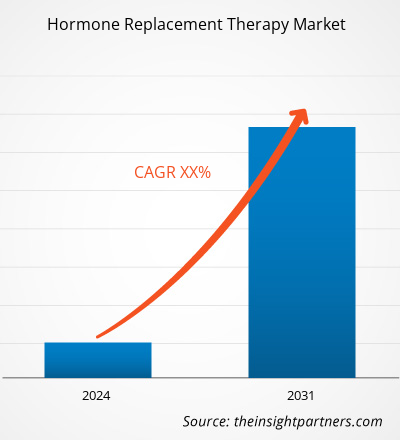Le marché des traitements hormonaux substitutifs (THS) devrait atteindre 35,91 milliards de dollars américains d'ici 2031. Ce marché devrait enregistrer un taux de croissance annuel composé (TCAC) de 6,0 % entre 2025 et 2031.
La demande mondiale de traitements hormonaux substitutifs ( THS ) est en constante augmentation, notamment en raison de la prévalence croissante des troubles hormonaux, d'une meilleure connaissance des carences hormonales et des progrès réalisés dans la formulation des THS . Grâce à son innocuité et son efficacité avérées, le traitement hormonal substitutif bio-identique ( THSB ) gagne en popularité par rapport aux hormones de synthèse. Issu de sources naturelles, le THSB est considéré comme plus proche des hormones produites naturellement par l'organisme.
Les entreprises pharmaceutiques investissent dans le développement de nouvelles formulations d'hormonothérapie, notamment des patchs transdermiques , des gels, des crèmes et des implants sous-cutanés, afin d'améliorer le confort des patientes, l'observance du traitement et la sécurité. Ce facteur stimule la croissance du marché des traitements hormonaux substitutifs. En août 2023, la Food and Drug Administration (FDA) a approuvé la demande abrégée de nouveau médicament (NDA) d' ANI Pharmaceuticals pour le gel d'estradiol à 0,1 %. Le médicament de référence, Divigel, est une hormonothérapie à base d'œstrogènes utilisée pour traiter les symptômes vasomoteurs modérés à sévères associés à la ménopause. La forme générique de Divigel est un gel d'estradiol à 0,1 %.
Facteurs de croissance :
La diversité des applications stimule la croissance du marché des thérapies de remplacement hormonal.
L'hormonothérapie substitutive (HTS) est prescrite pour traiter les symptômes de la ménopause, le déficit en hormone de croissance, etc., qui peuvent avoir un impact considérable sur la vie des personnes concernées. Des millions de femmes y ont recours , parfois pendant de longues périodes. L'HTS peut prévenir l'ostéoporose et améliorer la qualité de vie de diverses manières. Selon l'Oregon Health & Science University, le déficit en hormone de croissance ( DHC ) est rare et touche environ 50 000 adultes aux États-Unis et environ un enfant sur 4 000 à 6 000. Ainsi, l'utilisation croissante de ce traitement, associée à la prévalence grandissante de divers troubles hormonaux, stimule la croissance du marché de l'hormonothérapie substitutive.
Retenue:
Le coût élevé des médicaments freine la croissance du marché des thérapies hormonales substitutives.
Le coût des traitements hormonaux de substitution est relativement élevé. Par exemple, selon le Menopause Center, le prix d'une prescription de traitement hormonal substitutif par voie orale varie de 130 à 240 dollars américains par mois (soit de 1 560 à 2 440 dollars américains par an). Ce coût élevé limite l'utilisation régulière de ces produits et freine ainsi la croissance du marché des traitements hormonaux de substitution.
Vous bénéficierez d'une personnalisation gratuite de tous les rapports, y compris certaines parties de ce rapport, l'analyse par pays, le pack de données Excel, et vous profiterez également d'offres et de réductions exceptionnelles pour les start-ups et les universités.
Marché des traitements hormonaux substitutifs : Perspectives stratégiques

-
Découvrez les principales tendances du marché présentées dans ce rapport.Cet échantillon GRATUIT comprendra une analyse de données, allant des tendances du marché aux estimations et prévisions.
Segmentation et portée du rapport :
L'analyse du marché des traitements hormonaux substitutifs a été réalisée en prenant en compte les segments suivants : traitement, application, voie d'administration et utilisateur final.
Le marché des traitements hormonaux substitutifs est segmenté, selon le type de thérapie, en traitements à base d'œstrogènes, d'hormone de croissance, d'hormones thyroïdiennes, de testostérone et autres. Le segment des traitements à base d'œstrogènes détenait la plus grande part de marché en 2023.
Le marché des traitements hormonaux substitutifs est segmenté, par application, en ménopause, déficit en hormone de croissance ( GH ), hypothyroïdie, hypogonadisme et autres. Le segment de la ménopause détenait la plus grande part de marché en 2023 et devrait enregistrer le taux de croissance annuel composé (TCAC) le plus élevé au cours de la période de prévision.
Analyse régionale :
En termes de régions, le rapport sur le marché des traitements hormonaux substitutifs couvre l'Amérique du Nord, l'Europe, l'Asie-Pacifique, l'Amérique du Sud et centrale, ainsi que le Moyen-Orient et l'Afrique. En 2023, l'Amérique du Nord détenait la plus grande part de marché. L'adoption croissante des technologies les plus récentes, la prévalence accrue des troubles hormonaux, l'adoption précoce de nouveaux produits et la présence d'acteurs clés du marché contribuent à la forte croissance du marché des traitements hormonaux substitutifs en Amérique du Nord. En juin 2023, le NGENLA (somatrogon-ghla), un analogue de l'hormone de croissance humaine administré une fois par semaine, a été approuvé par la Food and Drug Administration (FDA) américaine pour le traitement des enfants et adolescents de trois ans et plus présentant un retard de croissance dû à une sécrétion insuffisante d'hormone de croissance endogène, selon un communiqué de Pfizer Inc. et d'OPKO Health Inc.
Par ailleurs, une attention accrue portée à l'accès à des soins personnalisés de qualité et au renforcement du système de santé devrait créer d'importantes opportunités pour le marché de l'hormonothérapie substitutive au cours de la période prévisionnelle. En mai 2023, Hormones by Design, l'un des plus grands réseaux de cliniques d'hormonothérapie substitutive du Texas, a été acquis par Forum Health, LLC, le premier réseau national de prestataires de médecine intégrative et fonctionnelle.
Aperçu régional du marché des thérapies de remplacement hormonal
Les analystes de The Insight Partners ont analysé en détail les tendances régionales et les facteurs influençant le marché des traitements hormonaux substitutifs tout au long de la période prévisionnelle. Cette section aborde également les segments de marché et la répartition géographique des traitements hormonaux substitutifs en Amérique du Nord, en Europe, en Asie-Pacifique, au Moyen-Orient et en Afrique, ainsi qu'en Amérique du Sud et centrale.
Portée du rapport sur le marché des thérapies de remplacement hormonal
| Attribut du rapport | Détails |
|---|---|
| Taille du marché en 2024 | XX milliards de dollars américains |
| Taille du marché d'ici 2031 | 35,91 milliards de dollars américains |
| TCAC mondial (2025 - 2031) | 6,0% |
| Données historiques | 2021-2023 |
| Période de prévision | 2025-2031 |
| Segments couverts |
Sous-produit
|
| Régions et pays couverts |
Amérique du Nord
|
| Leaders du marché et profils d'entreprises clés |
|
Densité des acteurs du marché des thérapies hormonales substitutives : comprendre son impact sur la dynamique commerciale
Le marché des traitements hormonaux substitutifs connaît une croissance rapide, portée par une demande croissante des utilisateurs finaux. Cette demande est alimentée par l'évolution des préférences des consommateurs, les progrès technologiques et une meilleure connaissance des bienfaits de ces produits. Face à cette demande grandissante, les entreprises diversifient leur offre, innovent pour répondre aux besoins des consommateurs et tirent parti des tendances émergentes, contribuant ainsi à la croissance du marché.

- Obtenez un aperçu des principaux acteurs du marché des thérapies hormonales substitutives.
Évolutions du secteur et perspectives d'avenir :
Voici, d'après les communiqués de presse des principales entreprises, les développements stratégiques des acteurs majeurs du marché de l'hormonothérapie :
- En janvier 2024, Ascendis Pharma A/S (Danemark) et Vector Pharma FZCO (Vector) ont conclu un accord de distribution exclusive pour la commercialisation de Yorvipath et Skytrofa dans les pays du Conseil de coopération du Golfe (CCG) : Arabie saoudite, Émirats arabes unis, Koweït, Oman, Qatar et Bahreïn. Aux termes de cet accord, Vector mettra à profit son expertise en matière de vente et de marketing pour fournir aux patients de ces pays Yorvipath et Skytrofa, indiqués respectivement dans le traitement de l’hypoparathyroïdie chez l’adulte et du déficit en hormone de croissance chez l’enfant.
Paysage concurrentiel et entreprises clés :
AstraZeneca, Pfizer Inc., Novartis AG, Abbott, Tolmar Inc., Par Pharmaceutical, Mayne Pharma Group Limited, Novo Nordisk A/S, Eli Lilly and Company et Noven Pharmaceuticals, Inc. figurent parmi les entreprises majeures présentées dans le rapport sur le marché des traitements hormonaux substitutifs. Ces entreprises s'attachent à développer de nouvelles technologies, à améliorer leurs produits existants et à étendre leur présence géographique afin de répondre à la demande croissante des consommateurs à travers le monde.
- Analyse historique (2 ans), année de base, prévision (7 ans) avec TCAC
- Analyse PEST et SWOT
- Taille du marché Valeur / Volume - Mondial, Régional, Pays
- Industrie et paysage concurrentiel
- Ensemble de données Excel
Rapports récents
Témoignages
Raison d'acheter
- Prise de décision éclairée
- Compréhension de la dynamique du marché
- Analyse concurrentielle
- Connaissances clients
- Prévisions de marché
- Atténuation des risques
- Planification stratégique
- Justification des investissements
- Identification des marchés émergents
- Amélioration des stratégies marketing
- Amélioration de l'efficacité opérationnelle
- Alignement sur les tendances réglementaires






















 Obtenez un échantillon gratuit pour - Marché des thérapies de remplacement hormonal
Obtenez un échantillon gratuit pour - Marché des thérapies de remplacement hormonal